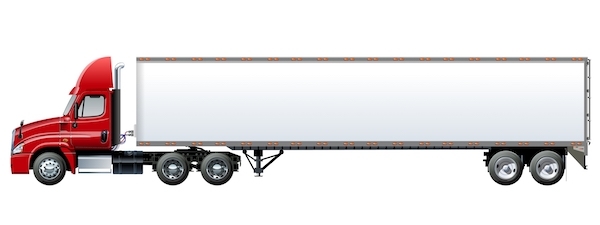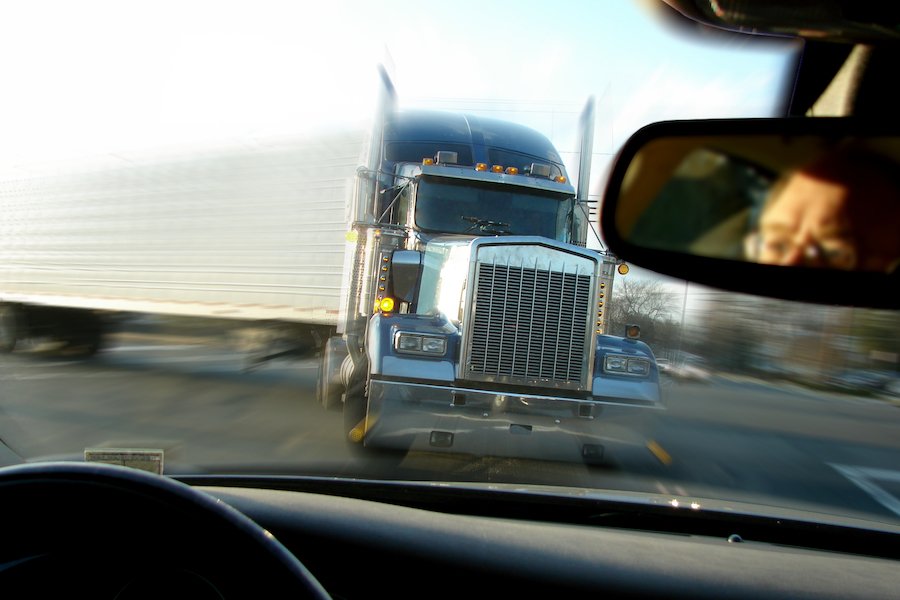
If you file a tractor-trailer accident lawsuit in Nevada against a big rig company, you may be able to recover damages for:
- doctor’s bills,
- lost salary, wages, and/or tips,
- loss of future earnings,
- pain and suffering,
- wrongful death damages, and/or
- punitive damages (if the driver intended to cause the accident)
Tractor-trailers, also called 18-wheelers, big rigs, or semi-trailer trucks, are the largest vehicles on Nevada’s roadways and can cause catastrophic collisions. Even if you contributed to a semi-trailer truck accident, Nevada’s comparative negligence laws may still permit you to recover damages.
Remember if you are in an 18-wheeler accident, cooperate with the police but do not admit fault. Also, do not speak to the other driver’s insurance company without an attorney. The driver’s insurance company may try to settle the matter for far less than you deserve.
In this article, our Nevada personal injury attorneys answer the following frequently-asked questions about filing tractor-trailer accident lawsuits.
- 1. What can I do if I got injured by a tractor-trailer in Nevada?
- 2. What money can I get if I am hit by a big rig?
- 3. Whom can I sue?
- 4. What if the 18-wheeler driver ran into me on purpose?
- 5. What if I was partially at fault?
- 6. When can I sue after a big rig accident in Nevada?
- Additional Reading
Also see our related article on Las Vegas truck accident lawsuits.
1. What can I do if I got injured by a tractor-trailer in Nevada?
If you are injured in a semi truck accident in Nevada, you can sue the driver and the driver’s employer for negligence. Negligence consists of four elements that you must prove in order to recover money:
- The defendant(s) owed you (the plaintiff) a duty of care;
- The defendant(s) breached this duty;
- This breach caused your injury; and
- This injury resulted in damages.1
Here is an example of how negligence by a semi truck driver and employer can result in a Nevada road accident:
Example: John, a truck driver, is late delivering a shipment. He has not slept in more than a day, but he is under his quota. Additionally, his employer told him to keep driving anyway despite not having slept. While driving on the I-15 in Las Vegas, John dozes off from fatigue and veers off the road and runs over a motorcyclist. The collision kills the motorcyclist instantly.
Here, the motorcyclist’s family would probably win a negligence lawsuit against the driver and the driver’s employer: The tractor-trailer driver and his employer had a duty of care to prevent driving with insufficient sleep.
John breached this duty by continuing to drive even though he had no sleep. Also, the company breached this duty by ordering John to keep driving even though they knew John was sleep-deprived.
John’s fatigue caused him to fall asleep at the wheel and run over the motorcyclist. Finally, the motorcyclist’s death resulted in damages, including funeral expenses and loss of earnings for his family.

Tractor-trailer drivers are the biggest class of drivers in Nevada, after commuters and tourists.
Tractor-Trailer Rules
The Federal Motor Carrier Safety Administration (FMCSA) and the Nevada Department of Transportation (NDOT) mandate several safety rules that tractor-trailer drivers and companies are required to follow. Some of these include:
- Drivers may drive up to eleven (11) hours a day;
- Drivers may work up to fourteen (14) hours a day (therefore, at least three (3) of those hours would be non-driving duties);
- Drivers may not operate a tractor-trailer for more than eight (8) hours without having a half-hour break.
- A loaded tractor-trailer may not weigh more than 129,000 pounds–approximately 60 tons.2
Accidents resulting from failure to follow these rules may be grounds for negligent lawsuits.
Tractor-Trailer Accident Causes
The typical reason behind a big rig accident is that the driver or trucking company was negligent. Examples of such negligence include:
- The driver was “driving drowsy” (as discussed above) because they ignored the sleeping, break, and driving time-limit requirements;
- The driver was under the influence of alcohol or drugs (DUI) in Nevada (learn more about commercial DUI);
- The driver was speeding, which may happen if they were late or under pressure by their employer to hurry;
- The semi was overloaded or improperly loaded with cargo;
- The driver backed up after failing to give proper warning (learn more about unsafe backing);
- The driver lost control while driving on an incline or decline;
- The driver operated the semi in a way that caused the road to collapse, such as driving too near the median, a work zone, or a soft shoulder; and/or
- The driver had insufficient training to operate the tractor-trailer
Note that if the semi-truck itself malfunctioned or was somehow defective, you may also be able to sue the truck manufacturer on strict liability grounds as well. Furthermore, the manufacturer may be on the hook for damages for breach of implied warranties and failure to warn.3
Tractor-Trailer Accident Injuries
Victims in big rig accident lawsuits typically suffer from severe injuries. 18-wheelers are the biggest vehicles on the road, weighing approximately 32,000 pounds with no cargo. So when they hit a pedestrian, bicyclist, sedan, SUV or even a pickup (which averages only 6,000 pounds), the fallout can be catastrophic and often deadly.
Typical big rig injuries include:
- bone fractures,
- maiming,
- brain injuries,
- collapsed lungs,
- spinal injuries, and
- burns, if the vehicles explodes into flames.
2. What money can I get if I was hit by a big rig?
As a victim in a big rig collision, you may be eligible to receive compensatory damages for:
- medical bills from hospitals, doctors and pharmacies;
- lost wages (while the injured party is too incapacitated to work);
- lost earning capacity (if the injury prevents the victim from future employment);
- pain and suffering, and/or
- wrongful death
Note that semi-trailer truck drivers who are government employees acting in the course of their jobs are liable for only $100,000 in medical bills and lost wages.4
3. Whom can I sue?
Possible defendants in Nevada big rig accident cases include:
- The driver of the semi truck;
- The employer of the semi truck’s driver; or
- The manufacturer of the semi truck, if the truck was defective.
Filing a lawsuit against the driver’s employer typically yields the largest financial rewards.
Depending on the case, there may also be a cause of action against the local or federal government if it failed to maintain a safe highway and proper signage.

Tractor-trailer crash victims may be able to recover ample compensatory damages.
4. What if the 18-wheeler driver ran into me on purpose?
18-wheeler operators who intentionally plow into other drivers or pedestrians may be ordered to pay punitive damages as well as compensatory damages. The Nevada damages cap for punitive damages is:
- $300,000 when the compensatory damages awarded are less than $100,000, or
- Three times (3) the compensatory damages when the amount of compensatory damages is $100,000 or higher.5
Note that tractor-trailer drivers who deliberately cause an accident face criminal charges as well.
5. What if I was partially at fault?
If you partially caused a big rig accident, you might be eligible for money damages if the defendant was at least 50% at fault. Your payout would just be reduced by your percentage of fault.
For example, if you were 25% at fault for a tractor-trailer collision because you drove too closely behind the semi, then you will receive 25% less damages than you would have if you were blameless. However, if you were 51% or more at fault for hitting the 18-wheeler, then you receive no damages at all.6
Contributing to a Tractor-Trailer Accident
Anyone sharing a road with a big rig is advised to drive cautiously. Examples of how non-commercial drivers contribute to an 18-wheeler collision are the following:
- driving in between two semi trucks when there is inadequate space;
- passing a semi truck when there is inadequate space;
- driving in the semi truck’s blind spot or other no-visibility zone;
- tailgating a semi truck;
- switching lanes quickly or without warning in front of a semi truck; and
- underestimating a semi truck’s speed while merging or making a turn against traffic.
Typical evidence lawyers use to try to determine fault in tractor-trailer accidents include:
- surveillance video,
- GPS records,
- weather reports,
- eyewitnesses, and
- photos of the damage and road conditions that you or others may have taken after the incident.
Another piece of valuable evidence can be the logbook that tractor-trailer drivers are required to keep. These books are supposed to document in fifteen (15) minute increments the drivers’ tasks, including working, driving, and breaks.
6. When can I sue after a big rig accident in Nevada?
If you are injured by a semi-trailer truck in Nevada, you typically have two (2) years following the incident to sue for negligence. Learn more about statutes of limitations.7
Additional Reading
For more information, our Las Vegas tractor-trailer accident attorneys recommend these scholarly articles:
- Costly Crashes: A Small-Town Personal Injury Case Sends a Powerful Message to the Trucking Industry – A.B.A. Journal.
- Evidentiary Issues in Trucking Cases – The Brief.
- Limiting Liability for Trucking Accidents by Uniting Safety and Claims Departments When Addressing the Preventability of Accidents – The Brief.
- The Right-to-Know and the Trucking Industry: Regulating Regulations – Transportation Law Journal.
- Trucking Accidents: Navigating Claims, Investigations, and Litigation – The Brief.
Legal References:
- See, for example, Scialabba v. Brandise Const. Co.,(1996) 112 Nev. 965, 921 P.2d 928.
- 23 CFR Appendix C to Part 658.
- See, for example, Valentine v. Pioneer Chlor Alkali, (1993) 109 Nev. 1107, 864 P.2d 295, 297.
- NRS 41.035.
- NRS 42.005.
- NRS 41.141.
- NRS 11.190.

